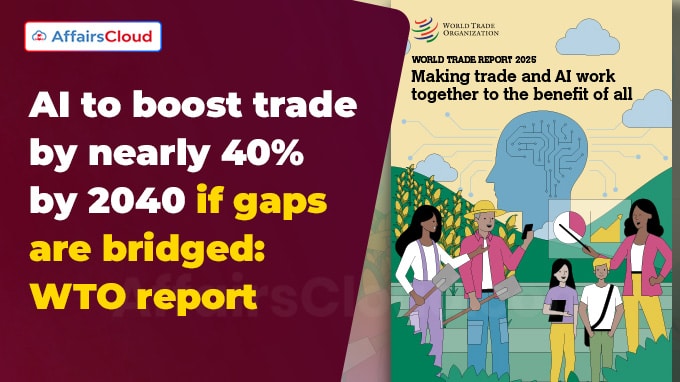 In September 2025, the World Trade Organisation (WTO) released its annual World Trade Report 2025 (WTR) titled “Making trade and AI work together to the benefit of all” at the annual WTO Public Forum in Switzerland. The report highlights that artificial intelligence (AI) could increase global trade by nearly 40% by 2040.
In September 2025, the World Trade Organisation (WTO) released its annual World Trade Report 2025 (WTR) titled “Making trade and AI work together to the benefit of all” at the annual WTO Public Forum in Switzerland. The report highlights that artificial intelligence (AI) could increase global trade by nearly 40% by 2040.
Exam Hints:
- What? Release of WTO Report 2025
- Title: Making trade and AI work together to the benefit of all
- AI Impact: By 2040 – Trade boost by 34-37%, GDP increase by 12-13%
- AI-Enabled Goods Trade: USD 2.3 trillion in 2023
- AI Patents: 10% rise in digital services trade
About World Trade Report(WTR):
Published annually since 2003, the WTR offers in-depth analysis of global trade trends, policy issues, and the multilateral trading system, helping policymakers, researchers, and the public better understand international trade.
Highlights of WTR 2025:
AI Impact: As per the report, AI could lead to significant increases in global trade, which is projected to rise by 34% to 37% by 2040, with the largest growth expected in the trade of digitally deliverable services.
- The AI is also projected to generate substantial global Gross Domestic Product(GDP) increases, ranging from 12 to 13% across scenarios.
- Also, it was found that nearly 90% of firms using AI report clear benefits in trade-related activities, with 56% noting improved trade risk management.
Productivity: A recent estimate suggests that AI could boost annual growth in Total Factor Productivity(TFP) by approximately 0.68% points.
- TFP measures how efficiently an economy uses its inputs, typically labour and capital.
AI on inclusive growth: WTO economists tested few AI adoption scenarios showing different levels of progress in policies and technology across economies.
- Benchmark scenario: In this scenario, Low-Income Economies (LIE) do not catch up with High-Income Economies (HIE) in terms of digital technology and infrastructure. As a result, income gains are projected at 14% for HIE, 11% for Middle-Income Economies (MIE), and 8% for Low-Income Economies (LIE).
- Digital Infrastructure (DI) improvement in LIE: Under this condition (improvement in DI in LIE), income growth is projected at 12% for both high- and middle-income economies, and 11% for low-income economies.
- Improved Infrastructure and Broad AI Adoption: In this scenario, low- and middle-income economies enhance both. This leads to higher projected GDP gains of 15% for LIE and 14% for MIE.
AI enabled Goods Trade: In 2023, global trade in AI-enabling goods – including raw materials, semiconductors and intermediate inputs valued at USD 2.3 trillion(tn).
AI Patents: WTO analysis states that a 10% rise in digital services trade links to a 2.6% increase in AI patent citations across countries.
Widening Digital Divide
Uneven adoption of AI: The 2025 WTO-International Chamber of Commerce(ICC) survey results show that only 41% of small firms report using AI, compared to over 60% of large firms.
- Among low-income and lower middle-income economies, fewer than one-third of firms use AI.
Subsidies: Global subsidies for AI-related products have grown significantly since 2010, recently surpassing 15%.
- Over 98% of these subsidies come from high- and upper middle-income countries, increasing the risk of AI capabilities becoming more concentrated.
Restrictions: The report also points to the need for open and predictable trade policies, noting that the number of quantitative restrictions applied to AI-related goods has climbed sharply over time, from 130 in 2012 to nearly 500 in 2024, driven by HIE and upper MIE.
- Access to AI-enabling goods remains uneven, with bound tariffs reaching up to 45% in some LIE.
About World Trade Organisation (WTO):
Director-General (DG) – Ngozi Okonjo-Iweala
Headquarters – Geneva, Switzerland
Established – 1995




